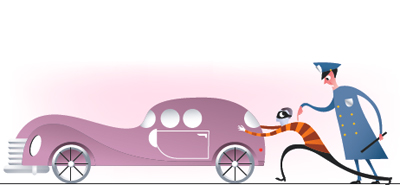 When young offenders given parole stand before Justice Lloyd Budzinski of the Ontario Court of Justice in Toronto, they get more than just the usual stern lecture about following curfew and avoiding their co-accused.
When young offenders given parole stand before Justice Lloyd Budzinski of the Ontario Court of Justice in Toronto, they get more than just the usual stern lecture about following curfew and avoiding their co-accused.
The veteran judge often hands out lengthy orders, tailored for the particular youth before him. He might ask that youth to set three goals for her probation year and require that she achieve all three. Or have an offender write him a letter every three months to detail the progress he is making in changing his life. Each exercise is designed to get young people pondering the impact of their actions.
“Some people are very dangerous and have to be locked up,” says Budzinski. “Some people need some employment to take them off the street. Others need some counselling to get them back in the right direction.” So when he sees potential, he tries to help turn things around.
Budzinski is not alone in believing in a one-on-one, empathetic approach to justice. Many who work in criminal law say projects that embrace compassion, education, prevention, second chances and community-based efforts have the ability to change lives and impact the safety of our streets.
Canadian initiatives that promote these ideals are part of the reason, in addition to changes in demographics, that we’re seeing crime rates drop to their lowest levels in nearly 40 years. (In the sidebars that accompany this story, you can read more about how hot spot policing, car immobilizers and geography also contribute to fighting crime.)
On-the-ground experience, meanwhile, suggests that the stricter enforcement rules set out by the federal government’s Bill C-10 — which introduces mandatory minimum sentences and harsher sentences for many crimes — could reverse all this hard work.
Those in the legal profession who deal with criminal law say there’s no better way to understand crime than by looking at troubled youth and the neighbourhoods they come from. “Youth crime is driven by peers, poverty and a feeling that there’s lack of opportunity,” says Andrew Faith, a former Toronto West assistant Crown who worked with youth from the Jane and Finch area.
The statistics bear this out: people from disadvantaged groups — those from low-income backgrounds and certain ethnic minorities, for instance — are overrepresented in the prison population.
“A recurring theme in criminal law is people who have lost all hope, whether it be through family problems, mental illness, finances or the implementation of severe sentences,” says Toronto criminal lawyer Sean Robichaud. “The most dangerous person is someone who has nothing to lose, or nothing to gain by being good.”
Still, the very act of giving someone a second chance can inspire hope and a sense that change is possible. Many judges, lawyers and grassroots programs advocate for these compassionate second chances. Our legal system also helps — if that person is young. The Youth Criminal Justice Act, implemented in 2003, is designed to rehabilitate young people, not just incarcerate them.
And it’s working — by 2010, the number of youth accused had dropped by 11 percent.
But those who work in the criminal courts on a regular basis say that despite all we know about crime, we’re still not doing all we can to prevent it. For instance, we have few programs that help older, lifelong criminals, and we’re not making enough efforts to help those with mental illness who break the law. Existing social programs have not broken the cycle of poverty and lack of education that lead to crime for so many.
“We all know what influences crime,” says Faith, now a founding partner of Polley Faith LLP. “It’s like smoking and cancer, we know the link, there’s no mystery there. But we’re treating the symptoms, we’re not going to the source.”
5 crime-fighting numbers
 18 — The age when Canadians are most likely to commit a crime: there are about 14,000 offences per 100,000 people for this age group. The country’s median age is 40 and these middle-agers commit around 6,000 criminal acts per 100,000 people. One good thing about an aging population: less crime.
18 — The age when Canadians are most likely to commit a crime: there are about 14,000 offences per 100,000 people for this age group. The country’s median age is 40 and these middle-agers commit around 6,000 criminal acts per 100,000 people. One good thing about an aging population: less crime.
41 — The percentage by which the number of homicides by long guns in Canada decreased since the endlessly debated, and recently scrapped, long-gun registry was launched in 1995. Over the same time period, handgun homicides climbed five percent.
47 — The average percentage by which crime has been reduced in 33 Vancouver parking lots where the owners improved lighting and increased patrolling. The Safer Parking Initiative was launched in 2008 by the Vancouver Police Department and follows a model developed in the U.K.
5 — The dollar value of the Tim Hortons gift cards non-violent offenders receive as rewards from a drug treatment court for good behaviour, such as passing drug tests. Offenders who get tried in one of these courts (there are a handful across Canada) don’t go to jail but get treatment and must visit court weekly for up to 18 months.
52 — Percentage of the 108,529 drug offences committed in Canada in 2010 credited to cannabis possession. Trafficking, production or distribution of cannabis represents another 17 percent.
Hands off, Winnipeg car thieves!
 The Winnipeg Auto Theft Suppression Strategy has reduced auto thefts in this former auto theft national capital by 76 percent since 2004 — that’s an average of 24 stolen vehicles a day down to just five. Here’s how:
The Winnipeg Auto Theft Suppression Strategy has reduced auto thefts in this former auto theft national capital by 76 percent since 2004 — that’s an average of 24 stolen vehicles a day down to just five. Here’s how:
- The owners — Owners of cars on the at-risk list are required to install a free electronic immobilizer — it will shut down the car during a heist.
- The police — Winnipeg’s 16-member Stolen Auto Unit covers the city seven days a week and keeps constant tabs on known young offenders.
- The thieves — The Peg’s top car thieves get checked on by phone every three hours after curfew and meet daily with their parole officers.
The 411 on a proposed national crime reduction board
 What’s a national crime reduction board?
What’s a national crime reduction board?
University of Ottawa professor and criminologist Irvin Waller, author of Less Law, More Order: The Truth About Reducing Crime, proposes a board that would gather the best minds from public health, social services, police, provincial governments and academia to analyze which crime prevention measures in the country are working and share the info with those who can use it.
Why do we need it?
“It’s about balancing government policy, and going from a piecemeal approach with some successes in Canada, to a universal, better funded, better sustained strategy,” says Waller.
Who’s already doing it?
Similar boards exist around the world, and across Canada at municipal and provincial levels. Alberta’s Crime Prevention Task Force, for one, is getting great results. Scotland’s Violence Reduction Unit has helped get crime to below 1976 levels in that country.
What will it cost?
Waller says a board that would reduce crime by 50 percent in under 10 years would require an investment of $600 million a year.
So hot
 In policing, it’s not the size of your force, but how you use it.
In policing, it’s not the size of your force, but how you use it.
Hot spot policing works on the theory that crime doesn’t blanket a city evenly, and targeting specific areas with focused police efforts can reduce criminal activity.
A 2007 review out of Harvard of numerous hot spot studies found the technique reduced crime and calls to police.
The Toronto Anti-Violence Intervention Strategy is one of the country’s most visible hot spot-like policing programs, and gets much of the credit for the city’s four-year homicide rate drop.
It also inspired the creation of a guns and gangs rapid response strategy now implemented in 22 communities across Ontario.
Capitals of crime
 Think Toronto is the law-breaking capital of Canada? Think again. In fact, our largest city doesn’t have the highest rates per capita of any major crime. But check out these seven smaller municipalities and their crime claims to fame:
Think Toronto is the law-breaking capital of Canada? Think again. In fact, our largest city doesn’t have the highest rates per capita of any major crime. But check out these seven smaller municipalities and their crime claims to fame:
- Prince George, B.C.: Most dangerous city
- Vancouver: Bank robbery capital
- Edmonton: Murder capital
- Winnipeg: Robbery capital
- Belleville, Ontario: Breaking and entering capital
- Joliette, Quebec: Auto theft capital
- Saint John, N.B.: Sexual assault capital
Illustrations by James Turner

